Join Our Groups
TOPIC 6: AIR COMBUSTION, RUSTING AND FIRE FIGHTING
Composition of air
Air is a mixture of different gases. The gases that make up the air include nitrogen, oxygen, carbon dioxide, noble gases (argon, helium, neon, krypton and xenon) and a little water vapour. Air may also contain traces of impurities such as carbon monoxide (CO), sulphur dioxide (SO2), hydrogen sulphide (H2S) and other gases. The presence of these gases in air results in air pollution. Table bellow shows the composition of air by volume. The proportion of water vapour and impurities in air is very variable.
The Gases Present in Air and their Proportions
Name the gases present in air and their proportions
The composition of air is not exactly the same everywhere. It changes slightly from day to day and from place to place. There is more water vapour in the air on a damp day and in air above water bodies such as oceans, seas, lakes, rivers, etc. Over busy cities and industrial areas there is more carbon dioxide. But the uneven heating of the earth's surface by the sun causes the air to move continually, resulting in winds. The resultant winds spread the pollutants around.
The percentage composition of air by volume
| Gas | Approximate percentage |
| Nitrogen | 78.00% |
| Oxygen | 21.00% |
| Noble (rare) gases mainly argon | 0.94% |
| Carbon dioxide | 0.03% |
| Water vapour | 0 – 4% |
The Presence of Different Gases in Air
Demonstrate the presence of different gases in air
The determination of air by mass was carried out by Dumas in 1841. The apparatus used consists of three units as shown bellow.
The three parts of the apparatus include the following:
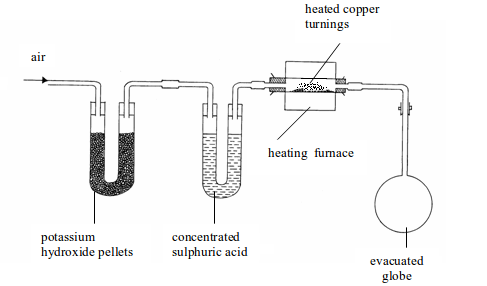
Determination of the composition of air by weight
- Several U-tubes containing potassium hydroxide pellets to remove carbon dioxide (only one tube shown in the figure for simplicity).
- Another set of U-tubes containing concentrated sulphuric acid to remove water vapour (only one tube shown in the figure).
- A heated, weighed glass tube containing finely divided copper to absorb oxygen.
The three parts of the apparatus would, therefore, remove all carbon dioxide, water vapour and oxygen contained in air. The remaining gas which enters the weighed evacuated flask (globe) will be atmospheric nitrogen and, of course, plus the rare gases. The copper will have reacted with all oxygen to form copper (II) oxide. The increase in mass of the copper will give the mass of oxygen. The increase in weight of the globe will be due to the weight of nitrogen and the rare gases. If we neglect the weight of carbon dioxide, the percentage of oxygen by mass (weight) in dry, pure air is 23.2% and the remaining 76.8% is the percentage of nitrogen and rare gases.
The presence of nitrogen in air
In order to demonstrate the presence of nitrogen in air, we need to carry out an experiment that will convert the nitrogen of the air into a chemically recognizable substance. This is easily done by strongly heating magnesium in the residual gas from the above experiment. Magnesium and nitrogen will react thus:
Upon treatment with water, magnesium nitrite gives ammonia gas. The gas can be recognized by its characteristic smell and its action of turning red litmus paper to blue.

The presence of oxygen in air
Oxygen is known as the active portion of the air because it supports combustion and combines with many other substances. Its presence and composition in air can be determined by using these properties. Any of the following two (2) experiments can be used to determine the composition, by volume of oxygen contained in air.
The Percentage of Oxygen in Air Experimentally
Determine the percentage of oxygen in air experimentally
1. Experiment. Determination of the presence and proportion of oxygen in air by combustion of a candle
Method
- Place a small candle on a plastic lid or any object that can float. Then set up the apparatus as shown in figure bellow. Sodium hydroxide is used in order to absorb the carbon dioxide gas produced by a burning candle.
- Light the candle and place the measuring cylinder over the top. Note the level of sodium hydroxide solution in the measuring cylinder at the start. A candle will stop burning (go off) once all the oxygen in the cylinder is used up.
- When the candle goes off, leave the apparatus to cool to room temperature. The purpose of cooling is to let the heated and expanded air to return to its normal condition. Then note the level of sodium hydroxide solution in the measuring cylinder.
.
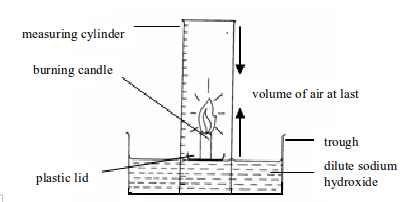
Determining the presence and percentage composition of oxygen in air by burning a candle
Observation and findings
The oxygen in air enclosed in the measuring cylinder is used to burn the candle to produce carbon dioxide gas. The carbon dioxide so produced dissolves in sodium hydroxide solution. The dissolved carbon dioxide causes the level of sodium hydroxide solution to rise up. The oxygen gas used to burn the candle is practically equal to the amount of carbon dioxide produced. This fact is, therefore, used to calculate the percentage of oxygen in air.
Model results
In the experiment, the initial volume of air was found to be 70.5 cm3 and the final volume was 55 cm3. The percentage of oxygen in the air is calculated in two steps:
1. To find the volume of oxygen used up to burn the candle (which is practically equal to the volume of carbon dioxide produced and then absorbed by sodium hydroxide), we subtract the final volume of air from the initial volume
Volume or oxygen used = Initial volume of air – final volume of air
Therefore, the volume of oxygen used for combustion of the candle = 14.7 cm.

Alternatively, the volume of oxygen used up can be calculated by subtracting the initial volume of sodium hydroxide solution from the final volume. That is: Volume of oxygen used = final volume of sodium hydroxide – initial volume of sodium hydroxide = Volume of carbon dioxide dissolved in sodium hydroxide.

Therefore, the percentage of oxygen =
In practice, it is difficult to get an accurate result with the above experiment.

This is due to a number of reasons such as:
- Not all the carbon dioxide is absorbed by the sodium hydroxide.
- The candle may go out (stop burning) before all the oxygen is used up due to accumulation of carbon dioxide in the cylinder.
- The heating of the air inside the measuring cylinder causes the gases to expand. This is why it is essential that the gases be allowed to cool to room temperature before reading the level.
Experiment withcombustion of copper in airgives the more accurate results than the combustion of the candle. The copper reacts with oxygen in the air to give copper (II) oxide.
2. Experiment . Determination of the presence and proportion of oxygen in air by the combustion of copper in air
Method
- Set up the apparatus as shown in figure bellow. Syringe A should contain 100 cm of air, syringe B should be empty.
- Heat the copper strongly and pass the air from syringe A back and forth (by pushing the piston of the syringe inward and outward) over the copper turnings a few times. Allow the air to cool and measure the volume of air in syringe A.
- Repeat the heating and cooling until the volume of air that remains in syringe A is constant. The copper is heated and cooled several times to ensure that it reacts with all oxygen in the sample of air.
`
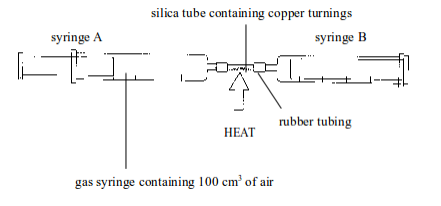
Determining the presence and percentage composition of oxygen in air by heating copper
Observations and findings
2. The final volume of air in the syringe, at the end of the experiment, is less than that of the original volume. This is because oxygen in the original air has combined with copper

Model of result
The volume of air in the syringe at different heating and cooling is as shown below:
Initial volume before heating = 100
Volume after first heating and cooling = 82
Volume after third heating and cooling = 79
The volume of oxygen used up = Initial volume of air before cooling - volume of air after the last heating and cooling
= 100 - 79
= 21
The presence of carbon dioxide in air

Carbon dioxide is present in air to the extent of 0.03% by volume. The gas is formed during the combustion of all common fuels – wood, coal, coke, natural gas, petrol, diesel, paraffin oil, etc, all of which contain carbon.
It is breathed out as a waste product of respiration by all animals. All sorts of combustion and burning produce carbon dioxide. The gas produced by all these processes accumulates in air. However, the amount of carbon dioxide in air remains constant instead of the tremendous quantities released into the atmosphere. This is because plants take up carbon dioxide. They then convert it into complex starchy compounds during photosynthesis. The gas also dissolves in ocean water and other water bodies.

The presence of carbon dioxide in air can be shown by passing air through a test tube containing some limewater (figure 6.5). After a time, the limewater turns milky. This shows the presence of carbon dioxide.
The reaction involved is as follows:
``
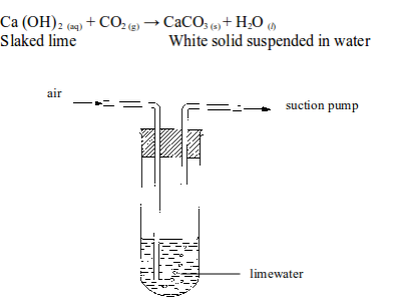
Testing for the presence of carbon dioxide in air
The presence of water vapour in air
Water vapour is present in air in varying quantities. It is given off by evaporation from the oceans, lakes and rivers. The presence of water vapour in air can be demonstrated by exposing deliquescent substances to the air on a watch glass. These are substances which when exposed to air tend to absorb much moisture from the air, dissolve in that moisture, and finally form a solution. Examples of deliquescent substances include calcium chloride, sodium hydroxide and phosphorous pentoxide.
The resulting solution is distilled. The colourless liquid obtained from distillation may be proved to be water by various water tests such as use of cobalt chloride paper or anhydrous copper (II) sulphate. The cobalt chloride paper turns from blue to pink in the presence of water. The white anhydrous copper (II) sulphate turns blue. Any of the two tests confirms the presence of water.
Alternatively, one may expose the anhydrous copper (II) sulphate salt to open air straight away for quite some time and then observe any change in its colour and/or form. Upon absorption of water vapour from the air, the white, powdery and anhydrous copper sulphate salt turns into hydrated blue crystals.
The noble (rare) gases
About 1% of the air by volume is made up of the noble gases. The most abundant of the noble gases is argon. Others are neon, xenon, krypton and helium. The proportion of these four is very minute. Argon and neon are used in “gas-filled” electric light bulbs and coloured “neon” electrical signs. They are obtained from liquefied air.
Air pollutants
The air always contains small quantities of many gases. Such gases include hydrogen sulphide, sulphur dioxide, as well as dust and other solid particles, especially in industrial areas. These gases are given off during the combustion of coal, and the fuels resulting from coal.
SEPARATION OF AIR INTO ITS CONSTITUENT GASES
The air we breathe is necessary to keep us alive. It is also a chemical resource. Oxygen is used in steel making, and nitrogen is used in making fertilizers. To use these gases in this way, they must be separated from the atmospheric air. Air, as we studied in chapter 5, is a mixture of different gases. The method used to separate its constituent gases is fractional distillation. The gases have to be liquefied so that the mixture can be fractionally distilled.
The process of separating the air into its constituent gases is difficult. It cannot be done in the laboratory. It is only done in industry. The chemical industry needs the gases from the air in their pure form.
The fractional distillation of air involves essentially two stages:
- First, the air must be cooled until it turns into a liquid.
- Then, the liquid air is allowed to warm up again. The various gases boil off at different temperatures
Stage 1: Liquefaction of air
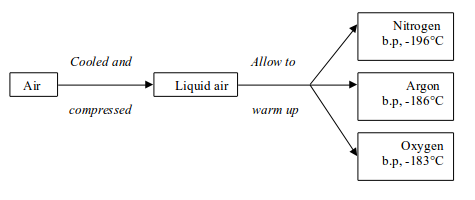
- Air is filtered to remove any dust particles (purification).
- The air is cooled to -180°C to remove the water vapour and carbon dioxide.
- The air is then compressed to 100-150 atmospheres. As the compressed air gets very hot, it has to be cooled.
- The compressed cooled air is allowed to expand rapidly. The rapid expansion cools the air to very low temperatures, and the liquid drops out. At -200°C, only helium and neon remain as gases. The cold gases are used to cool the compressed air.
Stage 2: Fractional distillation of liquid air
The air is cooled and compressed to form liquid air. The liquid air is allowed to warm up. Nitrogen boils off first because it has a low boiling point, -196°C. Argon follows by boiling at -186°C and finally oxygen at -183°C
Figure above illustrates all the steps that take place during the process.
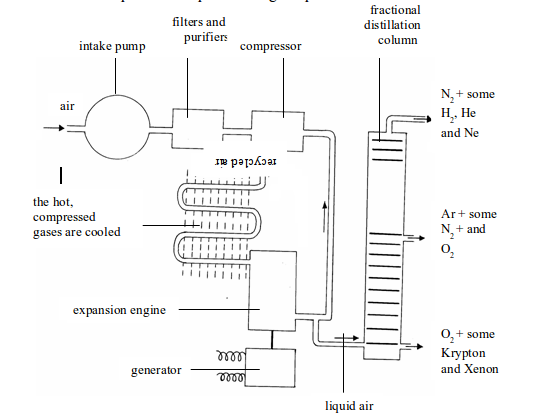
Fractional distillation of liquid air
Combustion
The Concept of Combustion
Explain the concept of combustion
Combustion of a substance in oxygen or air is so common that it becomes almost a habit to use the word "combustion" as if it referred to this kind of reaction alone. In real sense, it may be applied to any chemical reaction accompanied by light and heat in which one or more of the reactants are gaseous.
Many common substances burn in air. Substances such as coal, wood, kerosene, petrol, etc, burn in air. Any substance that burns is called a combustible material. The air or oxygen that supports the combustion is called a supporter of combustion. This is because we live in an atmosphere of air that contains oxygen, which is a very reactive gas. The gas surrounds any burning material. Oxygen is regarded as a supporter of combustion. However, it can sometimes combine chemically with the burning substance to produce a new substance, as we shall see later.
Combustion of a substance involves its reaction with oxygen and the release of energy. These reactions are exothermic and often produce a flame. An exothermic reaction is the one that is accompanied by release of heat to the surrounding environment. Combustion in which a flame is produced is described as burning. During burning energy is given out in the form of heat, light and sound.
The Combustion of Different Substances in Air and Analyse the Products
Demonstrate the combustion of different substances in air and analyse the products
Many different substances burn in air to produce different products. Here are examples of combustion of some common substances:
Sulphur
This is a yellow powder. When burnt in air, it gives misty fumes of sulphur dioxide gas.

Copper
When a piece of copper foil in a pair of tongs is held in a Bunsen flame, it becomes red-hot. On cooling, a black layer of some substance is observed. This black substance is copper oxide. The reaction occurs thus:

Magnesium
When one end of a piece of magnesium ribbon in tongs is placed in a Bunsen flame, it burns with a dazzling flame leaving a white ash. This white ash is magnesium oxide.

Hydrocarbons
Candle wax is a hydrocarbon. When it burns in air, the carbon and hydrogen of the wax react with the oxygen of the air to give carbon dioxide and water vapour respectively.

These are substances containing carbon and hydrogen only. The burning of these organic substances produces carbon dioxide and water vapour as the main products. If oxygen supply is low, combustion is incomplete and carbon monoxide may be formed.
Coal
Coal is a solid fuel that will burn in air to give the following products:

The Application of Combustion in Real Life
Describe the application of combustion in real life
1. The combustion of a natural gas is an important source of energy for homes and industry. Natural gas is mainly methane. Its complete combustion produces carbon dioxide and water vapour.

Substances like methane, which undergo combustion readily and give out large amount of energy, are known as fuels.
2. There are some reactions where fuels and other substances burn to produce a flame. These are combustion reactions. There are also other combustion reactions (exothermic) where no flame is evident. The most important of these is the crucial biochemical reaction that releases energy in our body cells called cellular respiration.
Our bodies need energy to make possible the reactions that take place in our cells. These reactions allow us to carry out our everyday activities. We need energy to stay alive. We get this energy from food. During digestion, food is broken down into simpler substances. For example, the carbohydrates in rice, potatoes and bread are broken down to form glucose. The combustion of glucose with oxygen in the cells of our body provides energy.

The reaction is exothermic and is known as cellular respiration.
3. We combust fuels to heat homes and keep ourselves warm, cook our food, and even burn wastes.
4. Combustion of fuels in automobile engines produces power (energy). This energy is supplied to different parts of motor vehicles to make them move from one point to another or carry out some crucial activities such as grinding, pumping, hauling etc. The operation of such machines could be impossible without combustion of fuel that produces energy to make them work.
5. Combustion of fuel in different burners produces heat and light used for different purposes in a chemistry laboratory.
6. Extraction of metals: Moderately reactive metals such as zinc, iron and lead are roasted in a special furnace (kiln) to form oxides. The resulting oxides are then reduced with carbon to get the pure metal. This process of extracting a metal from its ore by heating is called smelting.
7. In metallurgical industry, combustion is used during welding. Welding is the process of joining metals by melting the parts and then using a filler to form a joint. It can be done using different energy sources, including a gas flame.
Fire fighting
Firefighting is the act of extinguishing destructive fires. A fire fighter fights these fires to prevent destruction of life, property and the environment. Firefighting is a highly technical profession that requires training and education in order to become proficient.
Types of Fires According to their Causes
Classify types of fires according to their causes
Before starting to fight the fire, it is important to know the size and type of the fire that you are going to put off. The kind of firefighting material you are going to use will also depend on the type of fire in question. Fires are classified based on the type of burning materials.
1. Class A fires
These are the fires in which the burning materials are ordinary combustible materials such as paper, wood, cardboard, coal, rubber, clothing, furniture and most plastics. Water is the best extinguisher for these fires. However, any other type of extinguisher, except carbon dioxide, may be used.
2. Class B fires
These fires involve flammable liquids such as petrol, kerosene, oil, alcohol, ether, vanishes, etc. For small fires, a fire blanket or sand may be used. If the fire is large, use foam, dry powder or carbon dioxide extinguisher. Water should not be used on class B fires because the burning material, being lighter than water, will just float and spread the fire further.
3. Class C fires
The burning material involves flammable gases e.g. hydrogen, acetylene, coal gas, butane, methane, propane, etc. The best extinguishers to use in fighting against these fires are foam, dry powder or carbon dioxide extinguishers. It is important to turn off the gas supply, and spray water on the gas tank to cool it down.
4. Class D fires
The burning material is a metal. Alkali metals such as sodium or potassium may catch fire when they come in contact with water and oxygen. At high temperatures, many metals react with oxygen vigorously. Fires that involve burning metals should not be extinguished by water. This is because the burning metal can react with water to give hydrogen (another potential fuel). The appropriate extinguisher to use is foam or dry powder extinguisher.
5. Class E fires
These fires involve electrical equipment such as appliances, wiring, circuit breakers and outlets. You may use carbon dioxide or dry powder extinguisher to put off these fires. Never use water as it can conduct electricity and give an electric shock. Also remember to switch off power from the mains.
6. Class F fires
The burning material is cooking oil or fat. A cooking oil fire in the kitchen can be extinguished by covering the pan with a fire blanket or damp cloth. Foam, dry powder or carbon dioxide extinguishers also work by cutting off the air supply to the fire. For large fires, wet chemical extinguishers are recommended.
Different Types of Fire Extinguishers used to Extinguish Different Types of Fire
Identify different types of fire extinguishers used to extinguish different types of fire
Before choosing the best fire extinguishers for fighting different types of fires it is crucial to identify the type of burning materials first, and hence the type of fire such as:
Class A: Solids such as paper, wood, clothing, rubber, etc
Class B: Flammable liquids such as paraffin, petrol, oil, spirit, alcohol, etc.
Class C: Flammable gases such as propane, butane, methane, hydrogen, etc
Class D: Metals such as aluminium, magnesium, titanium, etc
Class E: Fires involving electrical equipment such as appliances, circuit breakers and outlets, etc.
Types of fire extinguisher to use for each type of fire
Water extinguisher
This is the cheapest and most widely used fire extinguisher. It is used for class A fires. It is not suitable for class B (liquid) fires, or where electricity is involved.
Foam extinguisher
This is more expensive than water extinguisher, but more versatile. It is used for classes A and B fires. Foam spray extinguishers are not recommended for fires involving electricity, but are safer than water if mistakenly sprayed onto live electrical apparatus.
Dry powder extinguisher
This is often termed as “multi-purpose” extinguisher, as it can be used on classes A, B and C fires. It is the best for liquid fires (class B). It will also efficiently extinguish class C (gas) fires. However, take care because it can be dangerous to extinguish a gas fire without first isolating the gas supply. Special powders are available for class D fires.
When powder-type extinguishers are used indoors, the powder can obscure vision or damage goods and machinery. It is also very messy.
Carbon dioxide extinguisher
Carbon dioxide is ideal for fires involving electrical apparatus (class E). It will also extinguish class B (liquid) fires. However, the extinguisher has no post-fire security and the fire could re-ignite.
Wet chemical extinguisher
This is a special extinguisher for class F fires. The extinguisher contains potassium salts. The salts not only help to cool down the flames but also form a ‘saponification’ blanket that effectively smothers the flames with thick, soapy foam.
Specialist powder extinguisher
This is a specialist fire extinguisher for use on class D fires (fires on combustible metals such as sodium, potassium, magnesium, lithium, titanium, manganese and aluminium), especially in the form of powder or turnings.
The Components Needed to Start a Fire
State the components needed to start a fire
To extinguish fire, it is necessary to remove one or more of the three components of combustion. Any fire needs a fuel, oxygen (air) and heat to keep it going. Remove any one of them and the fire will go out. These components are as shown in the fire triangle below.
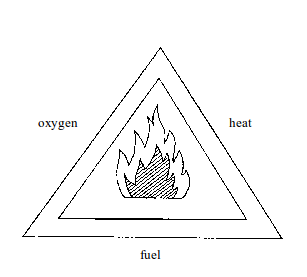
The fire triangle
A fire will continue or start to burn if these components are present:
(i) Fuel: This refers to any combustible material be it solid, liquid or gaseous material provided it can catch fire and burn. You can stop fire by removing the combustible material from the path of fire.
(ii) Oxygen (air): Oxygen supports combustion. A fuel will only burn if there is sufficient supply of oxygen. You can extinguish fire by displacing, or taking away oxygen supply from the fire or by blocking the gas supply to the fire.
(iii) Heat: The temperature should be at the kindling point of that fuel or above it. Every fuel has its own kindling point. Below the kindling point, the fuel will not catch fire. You can put out fire by lowering the temperature below the kindling point of a particular fuel. Water may be used to cool down the fuel. The vapourization of water absorbs the heat; it cools the smoke, air, walls, objects etc, which could be used as further fuel.
Fire Extinguishers According to the Chemicals they Contain
Classify fire extinguishers according to the chemicals they contain
Fire extinguishers are classified according to the type of chemicals they contain
1. Liquid carbon dioxide extinguisher
This extinguisher contains liquid carbon dioxide. The liquid is contained in a metal container. When the safety pin is removed, carbon dioxide evaporates as solid "snow" (carbon dioxide sublimes). The snow settles on the fire and suffocates it.
2. Soda-acid extinguisher
This extinguisher has a metal case containing soda (aqueous sodium carbonate or sodium hydrogen carbonate). In the metal case there is a glass bottle containing a concentrated acid (sulphuric or hydrochloric acid). There is a knob attached to the top of a metal case. Hitting this knob breaks the acid bottle thus bringing the acid and the soda into contact. The two react to give carbon dioxide, e.g.

The gas forms bubbles with the solution, thereby forming foam which is forced out of a jet of the case. The foam is directed to the fire where it covers the burning liquid, excluding all air from reaching the fire.
Some extinguishers are made in such a way that turning them upside down brings the soda and acid into contact and the reaction proceeds as stated above.

Soda-acid fire extinguishers
3. Foam extinguishers
This is different from the soda–acid type in that it contains sodium hydrogen carbonate in the metal case, but instead of the concentrated acid, it contains aluminium sulphate and saponium in the glass bottle. On mixing the three components, carbon dioxide gas is produced. The gas is ejected out as foam. The foam here lasts longer than the foam in the soda–acid extinguisher. The foam so produced also keeps air away from the burning material.
4. Dry chemical extinguisher
This extinguisher uses powdered sodium hydrogen carbonate and a nitrogen gas kept at high pressure. When the gas cartridge is broken using the top cap, the carbon dioxide under pressure propels the powder. The powder forms a layer over the burning material to keep air away.
Table bellow summarizes the types of fire extinguishers, indicating the chemicals they contain and the classes of fire they are suitable or unsuitable for.
Table: Types fire extinguishers and the chemical composition of their extinguishing agents
| Type | Chemical composition of agent | Suitable for | Unsuitable for |
| APW (Air- pressurized water) | Ordinary tap water pressurized with air | Class A | Class B, C, D and E (will spread the flame and make the fire bigger!) |
| Dry chemical(DC) | Fine sodium bicarbonate powder pressurized with nitrogen | Class A, B, C and E | - Class D- Aircraft and electronics ( corrosive to metals such aluminium)Note: -Though it is safe to use indoors it can obscure vision |
| CO2 | Non-flammable carbon dioxide gas under extreme pressure | Class B, C and E | Class A (leaves a flammable substance on the extinguished material which canre-ignite later ) |
| Halon | Bromochloro-difluoro-methane | Class A and E | Class B and C (least suitable) |
| Foam | Proteins and fluoro-proteins | Class A and B | Class E |
| Wet chemical(WC) | Potassium acetate | Class F | Class E |
| ABC | Mono-ammonium phosphate with a nitrogen carrier | Class A, Class B and C | Electronic equipment (leaves a stick y residue that may be damaging to electrical appliances such as a computer) |
| Specialist powder (SP) | Powders of NaCl, Cu or graphite under extreme pressure | Class D | Class A, B, C, E and F |
Precautions on using fire extinguishers
The following are some safety precautions you have to keep in mind when using fire extinguishers:
- Keep a reasonable distance from the fire as it may suddenly change direction.
- Never use a portable extinguisher on people, instead use a fire blanket.
- Do not test a portable extinguisher to see if it works. It may leak and later fail to work during an emergency.
- Do not return a used portable extinguisher to the wall. Make sure it is recharged first.
- When a fire gets out of control, notify the nearest fire brigade.
Rusting
The Concept of Rusting
Explain the concept of rusting
Rusting is the name given to the oxidation of iron or steel in damp air. It is also called corrosion. Rust is hydrated iron (III) oxide. It is a soft, crumbly solid and hence weakens the structure of iron and steel. During rusting, iron reacts with oxygen to form brown iron (III) oxide

At the same time the iron (III) oxide reacts with water to form hydrated iron (III) oxide (or rust):

Note: The x in the equation indicates that the number of water molecules in the hydrated iron (III) oxide can vary. So, both oxygen and water are needed to cause rusting of iron.
Rusting is a serious economic problem. Large sums of money are spent each year to replace damaged iron and steel structures, or protecting structures from such damages. Rusting of bridges, corrugated iron sheets on house roofs, containers, articles, etc. require an expenditure of big sums of money as well as labour for replacement. Rust weakens structures such as car bodies, iron railings, and ships’ hulls, and shortens their useful life. Preventing it can cost a lot of money. All efforts must be made to stop iron or steel items from rusting. This can be achieved if we know the conditions necessary for iron to rust.
The Conditions Necessary for Iron to Rust
Demonstrate the conditions necessary for iron to rust
When iron is left in contact with both water and oxygen (or air), it reacts to form hydrated iron (III) oxide. Iron will not rust on exposure to dry air or air-free water (water that has been boiled to expel all dissolved air) only. However, iron will easily and readily rust in water that has dissolved air in it. In figure 6.8, only the iron nail that is in contact with both water and air rusts. Therefore, rusting will only occur in the presence of both water and oxygen. If one of the two conditions is excluded, in one way or another, rusting will not take place at all.
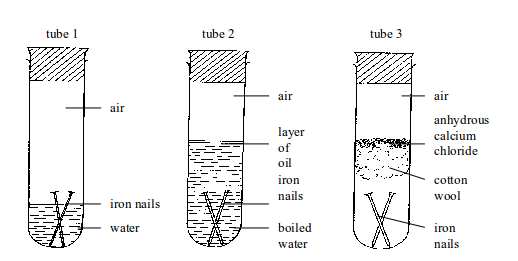
Testing for conditions necessary for iron rusting
Findings
Nails in tube 1 will rust. Nails in tubes 2 and 3 will not rust.
Reasons
In tube 1, nails are in contact with both water and air (oxygen). In tube 2, the water has been boiled to expel the dissolved air. In addition, any air above the water is prevented from dissolving in boiled water by a layer of oil. So, the nails are completely shielded away from air. Therefore, rusting is impossible. In tube 3, nails are in contact with air only. The moisture present in air is absorbed by anhydrous calcium chloride. Any moisture that might have been absorbed by the anhydrous calcium chloride is prevented from reaching the nails by a tuft of cotton wool. The cotton wool also absorbs some moisture directly from the air. Therefore, tube 3 will always carry dry air (moisture-free air). Hence, no rusting of iron nails occurs.
This experiment demonstrates the fact that for iron to rust, both water and air (oxygen) must be present. If one of these conditions is controlled, no rusting can take place.
Similarity between rusting and burning
Chemically, rusting and burning are similar processes in that they both require oxygen. Consider the burning of magnesium to give magnesium oxide.

In this process, magnesium combines with the oxygen of the air to form magnesium oxide.
During rusting, iron combines with oxygen of the air in the presence of water to form brown hydrated iron (III) oxide, "rust."

In addition, the two processes, burning and rusting, are exactly similar in that they both generate heat. The only difference is in the time required for each of the two processes to take place. During rusting heat is given out, but without being noticed because of its slower rate of production. Burning produces noticeable heat and light.
The Different Methods of Preventing Iron from Rustin
Describe the different methods of preventing iron from rusting
We have learned that for iron to rust there must be direct contact between the iron and both water and oxygen from the air. Therefore, in order to stop rusting we must protect iron from either water (moisture) or oxygen (air) or both. The following are some of the methods used to prevent iron from rusting:
Painting
Painting the iron article creates a waterproof and airproof cover over the surface of the iron. This method is widespread for objects ranging in size from ships and bridges to garden gates. Paints that contain lead or zinc are mostly used. These paints are especially good for preventing rusting. For example, "red lead" paints contain an oxide of lead,.
As oxygen and water cannot reach the iron, it does not rust. However, if the paint layer is scratched off rusting may occur. So, regular repainting is necessary to keep this protection intact.
Oiling and greasing
The oiling and/or greasing of the moving parts of machinery forms a protective film, preventing rusting. Moving parts cannot be painted since the paint layer can be easily scratched off during movement. Again, the treatment must be repeated to continue the protection.
Plastic coating
Steel is coated with plastic for use in garden chairs, refrigerators, bicycle baskets, dish racks, etc. The plastic PVC (polyvinyl chloride), a trade name for polychloroethene, is often used for this purpose. Plastic is cheap and can be made to look attractive.
Electroplating
Electroplating is the coating of one metal with a layer of another metal by means of electrolysis, where the metal to be coated is the cathode and the coating metal the anode.
An iron or steel object can be electroplated with a layer of chromium or tin to protect against rusting. A ‘tin can’ is made of steel coated on both sides with a fine layer of tin. Tin is used because it is unreactive and non-toxic. However, if protective layer is broken, then the steel beneath will begin to rust. So, proper handling of tin-plated items is needed.
Galvanizing
An iron object may be covered with a layer of zinc. This is called galvanizing. Even if the zinc is scratched to expose the iron, the iron does not rust. This is because zinc is higher in the reactivity series than iron. So, zinc reacts with water and oxygen in preference to iron.
The zinc layer can be applied by several different methods. These include electroplating or dipping the object into molten zinc. When an iron or steel article is dipped into molten zinc and then removed, it becomes coated with a thin layer of zinc. The zinc forms a protective coat over the surface of iron. This process is used for dustbins, car bodies, barbed wires and motorway crash barriers.
Sacrificial protection
This is a method of rust protection in which blocks of a metal more reactive than iron are attached to the iron surface. Zinc and magnesium are more reactive than iron. When blocks of zinc or magnesium are attached to the hull of a steel ship or oil rig, it corrodes in preference to iron. This is called sacrificial protection because the zinc or magnesium is sacrificed to protect the iron. When the blocks are nearly eaten away, they can be replaced by fresh blocks. Underground gas and water pipes are connected by wire to blocks of magnesium to obtain the same protection.
It is not necessary to cover the whole surface of a steel article with the more reactive metal for sacrificial protection to work. A ship may have magnesium blocks riveted to its hull every few metres to prevent rusting of the whole hull.
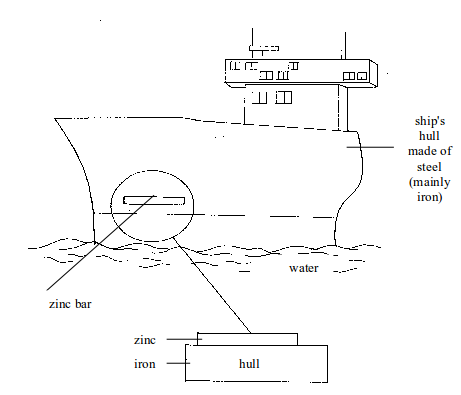
Blocks of zinc (or magnesium) attached to the hull of a ship
Alloying
Alloys are mixtures of metals. For example, iron can be mixed with small quantities of much less reactive metals to form an alloy called stainless steel. Stainless steel contains iron mixed with chromium, nickel and manganese. Stainless steel does not rust. It also has a very attractive appearance. It is used to make cutlery and kitchen equipment.
Use of silica gel
Silica is a common name for silicon dioxide (SiO2). Silica gel is a granular, vitreous, highly porous form of silica made synthetically from sodium silicate. Despite its name, silica gel is a solid. It is used as a desiccant, which absorbs moisture to prevent rusting of iron items or articles. Most often, a small bag of silica gel is put inside bags or boxes used for storing or carrying iron items to absorb any moisture that may cause rusting.






you are good
ReplyDeletethank you guys so much this really helps alot good job
ReplyDelete